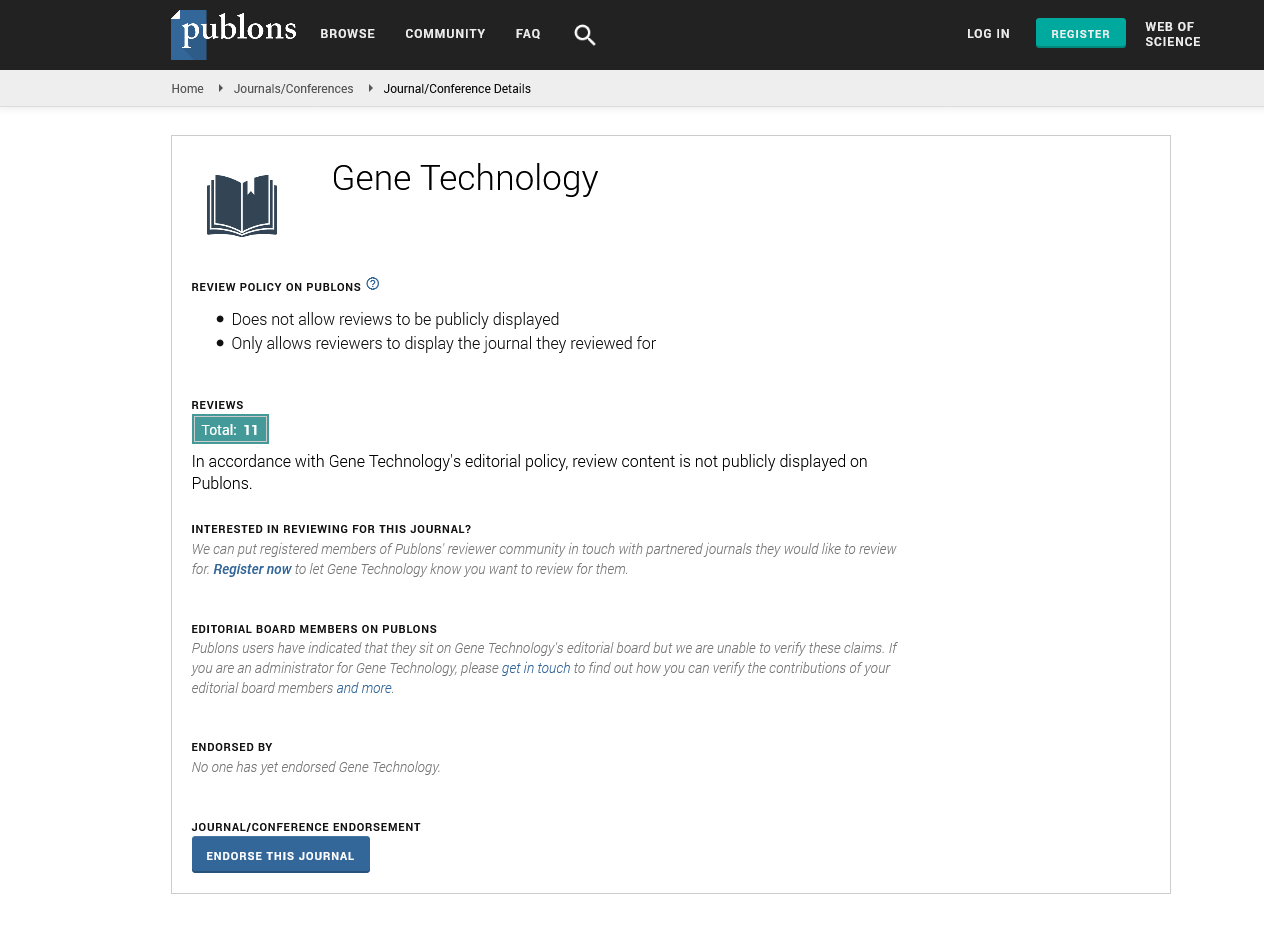PMC/PubMed Indexed Articles
Indexed In
- Academic Keys
- ResearchBible
- CiteFactor
- Access to Global Online Research in Agriculture (AGORA)
- RefSeek
- Hamdard University
- EBSCO A-Z
- OCLC- WorldCat
- Publons
- Euro Pub
- Google Scholar
Useful Links
Share This Page
Journal Flyer

Open Access Journals
- Agri and Aquaculture
- Biochemistry
- Bioinformatics & Systems Biology
- Business & Management
- Chemistry
- Clinical Sciences
- Engineering
- Food & Nutrition
- General Science
- Genetics & Molecular Biology
- Immunology & Microbiology
- Medical Sciences
- Neuroscience & Psychology
- Nursing & Health Care
- Pharmaceutical Sciences
Perspective - (2023) Volume 12, Issue 3
Developments of Safety and Efficacy in Adeno-Associated Virus Vectors in Gene Therapy
Thoas Yang*Received: 01-Jun-2023, Manuscript No. RDT-23-22133; Editor assigned: 05-Jun-2023, Pre QC No. RDT-23-22133 (PQ); Reviewed: 19-Jun-2023, QC No. RDT-23-22133; Revised: 26-Jun-2023, Manuscript No. RDT-23-22133 (R); Published: 03-Jul-2023, DOI: 10.35248/2329-6682.23.12.236
Description
Gene therapy has made use of Adeno-Associated Virus (AAV) vectors. AAV is a small, non-pathogenic virus that can carry genetic material from one cell to another. It has become an important tool for gene therapy due to its ability to deliver genetic material safely and specifically to target cells and tissues. Optimized AAV vectors have gained attention for their potential uses in human gene therapy. Optimization of the vector occurs by using various strategies that improve the efficiency of gene delivery, including improving thermo stability, increasing vector packaging capacity, and increasing transduction efficiency. These strategies can be combined into a single optimized vector with enhanced features. The benefits of optimized AAV vectors in human gene therapy are numerous. Optimized vectors can help reduce viral load while increasing transgene expression levels, resulting in more effective therapies with fewer adverse reactions. Optimized vectors can also increase the range of target tissues, allowing for more targeted delivery of therapeutic agents. Additionally, optimized vectors are more stable than non-optimized versions, ensuring greater safety and reliability during clinical trials.
Adeno-associated virus (AAV) vectors have become an increasingly popular option for delivering genetic treatments to humans. This is due to their effectiveness, low immunogenicity, and high efficiency for transduction of desired genes. The optimization of AAV vectors in gene therapy has made this method even more advantageous. One major benefit of optimized AAV vectors is improved delivery capability. These vectors are designed to target specific cell types more accurately, providing better delivery accuracy with fewer side effects. This ensures that the desired gene reaches its intended target and decreases any possibility of off-target activity.
Another advantage of optimized AAV vectors is increased safety. Newer vector designs contain minimal viral genetic material reducing the risk of unintended long-term consequences from the therapy. Furthermore, some newly developed AAVs require a specific enzyme for activation making it nearly impossible for them to replicate and spread throughout the body after administration or even cause disease. The most important advantage of optimized AAV vectors in human gene therapy is improved efficacy.
Noval generations of vector designs are more efficient at delivering genetic material into cells, allowing higher expression levels and greater therapeutic effects than traditional methods such as plasmid DNA delivery or viral vector delivery systems. Overall, optimized AAV vectors are a safe and effective way to deliver therapeutic genes into cells and provide better control over transduction accuracy than non-optimized options. With greater efficacy and fewer side effects associated with optimized vector designs. When it comes to developing effective gene therapy treatments, safety is a primary priority. Optimized AAV vectors have been widely used in therapeutic applications however there are several safety considerations to keep in mind when using them.
Finally experts recommend following Good Manufacturing Practices (GMP) guidelines when producing optimized AAV vectors for use in clinical trials or treatments. This involves producing vectors using high-quality raw materials and following strict sanitary processes to ensure purity and sterility of the product. Adeno-associated virus (AAV) vectors have become increasingly popular for use in human gene therapy applications due to their ability to effectively deliver genetic material into host cells. This has opened up a variety of potential applications, ranging from gene correction therapies to cancer treatments.
Optimized AAV vectors have been developed which offers several key advantages compared to traditional vectors and strategies for gene delivery. AAVs are non-pathogenic and possess a highly efficient transduction rate: they are able to penetrate cell membranes and remain stable for long periods of time, thus ensuring successful incorporation of the genetic material into the targeted cell. Furthermore, optimized AAV vectors can be used to precisely target the desired cell type, enabling the delivery of therapeutic genes only to certain cells and tissues while avoiding other areas.
The use of optimized AAV vectors can also reduce the risk associated with human gene therapy applications by minimizing the chances of unintended gene modifications or incorrect DNA integration. In addition, optimized AAVs can enable greater control over the dosage level administered in a particular patient. Optimized AAV vectors offer many benefits over other forms of gene delivery and have great potential for use in human gene therapy applications.
Citation: Yang T (2023) Developments of Safety and Efficacy of Adeno-Associated Virus Vectors in Gene Therapy. Gene Technol. 12:236.
Copyright: © 2023 Yang T. This is an open access article distributed under the terms of the Creative Commons Attribution License, which permits unrestricted use, distribution, and reproduction in any medium, provided the original author and source are credited.

